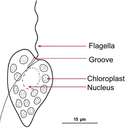en
names in breadcrumbs


The raphidophytes, formally known as Raphidomonadea[1] or Raphidophyceae (formerly referred to as Chloromonadophyceae and Chloromonadineae),[2] are a small group of eukaryotic algae that includes both marine and freshwater species.[3] All raphidophytes are unicellular, with large cells (50 to 100 μm), but no cell walls. Raphidophytes possess a pair of flagella, organised such that both originate from the same invagination (or gullet). One flagellum points forwards, and is covered in hair-like mastigonemes, while the other points backwards across the cell surface, lying within a ventral groove. Raphidophytes contain numerous ellipsoid chloroplasts, which contain chlorophylls a, c1 and c2. They also make use of accessory pigments including β-carotene and diadinoxanthin. Unlike other heterokontophytes, raphidophytes do not possess the photoreceptive organelle (or eyespot) typical of this group.
In terms of ecology, raphidophytes occur as photosynthetic autotrophs across a range of aquatic systems. Freshwater species are more common in acidic waters, such as pools in bogs. Marine species often produce large blooms in summer, particularly in coastal waters. Off the Japanese coast, the resulting red tides often cause disruption to fish farms, although raphidophytes are not usually responsible for toxic blooms.
The position of this group varied in former classifications. Some protozoologists treated the chloromonads as an order within the phytoflagellates.[4] Some phycologists classified them with the Xanthophyceae and the Eustigmatophyceae in the division Xanthophyta.[5] Others considered them as related to the Chrysophyceae, Dinophyceae, or Cryptophyceae [6]
Recently, the heliozoan Actinophyrida was moved to the group.
Classification based on Cavalier-Smith and Scoble 2013[7][8]
{{cite book}}: CS1 maint: uses authors parameter (link) The raphidophytes, formally known as Raphidomonadea or Raphidophyceae (formerly referred to as Chloromonadophyceae and Chloromonadineae), are a small group of eukaryotic algae that includes both marine and freshwater species. All raphidophytes are unicellular, with large cells (50 to 100 μm), but no cell walls. Raphidophytes possess a pair of flagella, organised such that both originate from the same invagination (or gullet). One flagellum points forwards, and is covered in hair-like mastigonemes, while the other points backwards across the cell surface, lying within a ventral groove. Raphidophytes contain numerous ellipsoid chloroplasts, which contain chlorophylls a, c1 and c2. They also make use of accessory pigments including β-carotene and diadinoxanthin. Unlike other heterokontophytes, raphidophytes do not possess the photoreceptive organelle (or eyespot) typical of this group.
In terms of ecology, raphidophytes occur as photosynthetic autotrophs across a range of aquatic systems. Freshwater species are more common in acidic waters, such as pools in bogs. Marine species often produce large blooms in summer, particularly in coastal waters. Off the Japanese coast, the resulting red tides often cause disruption to fish farms, although raphidophytes are not usually responsible for toxic blooms.
The position of this group varied in former classifications. Some protozoologists treated the chloromonads as an order within the phytoflagellates. Some phycologists classified them with the Xanthophyceae and the Eustigmatophyceae in the division Xanthophyta. Others considered them as related to the Chrysophyceae, Dinophyceae, or Cryptophyceae
Recently, the heliozoan Actinophyrida was moved to the group.